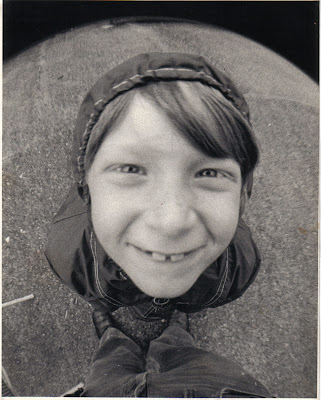Not my cousin my gastroenterologist

 I took the photograph (above) when I was about 15 and visiting my uncle, aunt, and cousins in London. It is of my cousin, Daniel Stern pictured in a more recent incarnation at right. His younger brother, Nick, is a doctor, in fact he is my cousin my gastroenterologist.
I took the photograph (above) when I was about 15 and visiting my uncle, aunt, and cousins in London. It is of my cousin, Daniel Stern pictured in a more recent incarnation at right. His younger brother, Nick, is a doctor, in fact he is my cousin my gastroenterologist.I was thinking about this image while listening to Dan's new CD, Traces

You can hear some of it here and here. The style is new jazz, harmonically complex, angular, yet accessible: tuneful, with naturally free-flowing rhythms and fresh orchestration. Dan's CD integrates composed music with improvisation. The CD is organized into two parts. The first, compositions for medium -sized jazz ensemble. The second is multi-tracked saxophone and clarinet. This includes versions of the medieval composer Perotin and the Renaissance composer Palestrina woven into the fabric of saxophone and clarinet compositions/improvisations. Illustrious performers including Dave Liebman, Dave Binney and Tim Garland are featured on the first part of this recording. It's all Dan all the time in the second.
In addition to the playing, one thing about this CD that is remarkable is that two parts of the CD each form part of a wholly integrated musical vision. The improvisations are conceived so as to flow out of the compositional context. The medium-sized ensemble works like a Mingus or a Braxton ensemble, with a natural flow from composed group material to individual improvisation. Dan has a keen ear for tone colour, and he creates beguiling orchestrations from various combinations of saxophones, clarinet and bass clarinet as well as the rhythm section.
The music based around the spinal material from polyphonic sacred music seems completely natural and yet arresting in its borrowing from music of the past. This isn't Jan Garbarek playing over top of the Hilliard Ensemble (as in their Officium), but a re-imagining of the material. Indeed the procedure (layers of new polyphonic saxophones and clarinet) seems perfectly appropriate to the material. From the middle ages to the Renaissance, composers have taken pre-existing material from the tradition and woven new material around it or treated it in different ways. Motets were often medieval mash-ups, adding new material to lines of Gregorian chant, and one or two parts from previous material.
This is an impressive CD: thoughtful, subtlely conceived, accessible music with a fresh sensibility, performed with great skill and intelligent charm.
*
TRUTH
I am in love with a goat
yes
perhaps I am a goat and
in love with myself
my keen sense of balance
my perfect beard
my killer backgammon skills
Oh how I could play
if I knew about justice
other goats or war
how I could bleat from the long grass
and always be true

Comments